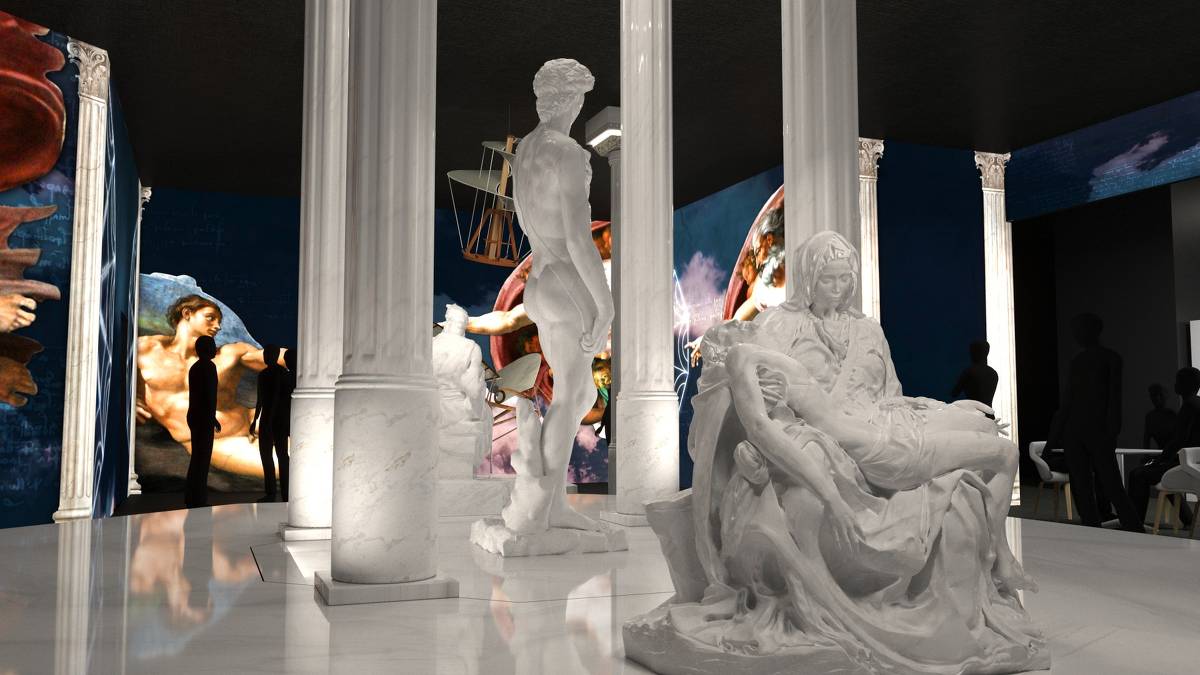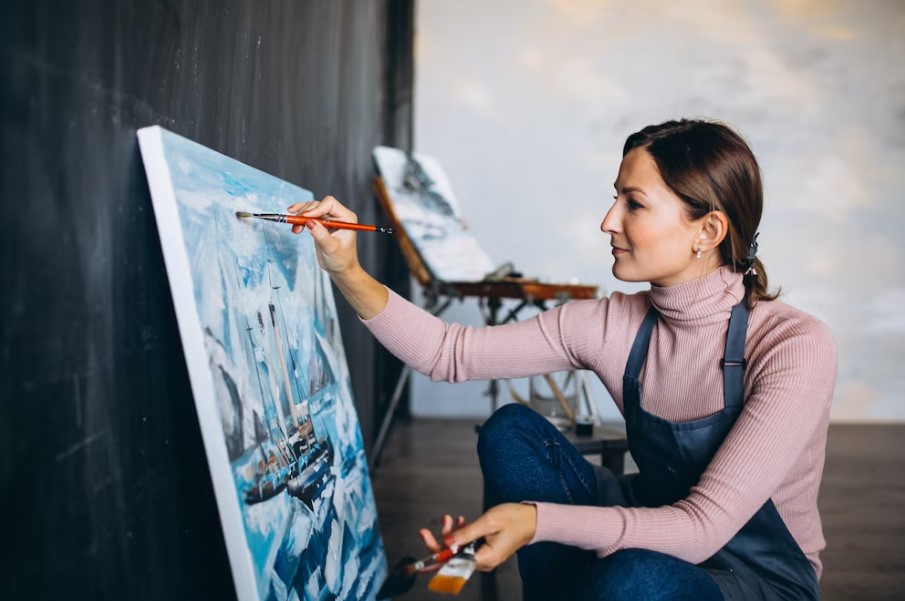Painting transcends traditional canvas boundaries, opening endless creative possibilities across surfaces you never imagined could become your next masterpiece. 🎨
Artists throughout history have experimented with unconventional surfaces, from Renaissance masters painting on wooden panels to contemporary creators transforming everyday objects into stunning works of art. Today’s artistic revolution encourages exploration beyond stretched canvas, inviting both professional painters and enthusiastic beginners to discover the unique characteristics and challenges that nontraditional surfaces present.
This comprehensive guide will walk you through the essential techniques, preparation methods, and creative approaches for painting on alternative surfaces. Whether you’re interested in transforming furniture, creating wearable art, or establishing yourself as a mixed-media innovator, understanding how to work with diverse materials will expand your artistic repertoire significantly.
Understanding Surface Science: Why Different Materials Matter 🔬
Before diving into specific techniques, understanding the fundamental properties of various surfaces will revolutionize your approach to nontraditional painting. Each material possesses unique characteristics affecting paint adhesion, absorption, and longevity.
Porosity determines how much paint a surface absorbs. Highly porous materials like untreated wood or fabric drink in paint quickly, requiring more product and potentially multiple coats. Non-porous surfaces such as glass, metal, or plastic resist absorption entirely, demanding special primers and paint formulations designed for these challenging substrates.
Flexibility is another critical consideration. Surfaces that bend, stretch, or move require flexible paint mediums that won’t crack under stress. This becomes particularly important when painting clothing, leather goods, or thin metals that experience regular manipulation.
Texture also plays a crucial role in your painting approach. Smooth surfaces like glass provide different visual effects compared to rough materials like brick or concrete, which add inherent texture to your finished piece.
Essential Preparation Techniques for Success 🛠️
Proper surface preparation represents the difference between artwork that lasts decades and paint that chips away within months. This fundamental step cannot be overlooked, regardless of your chosen surface.
Cleaning: The Foundation of Adhesion
Every nontraditional surface must be thoroughly cleaned before paint application. Oils, dust, residues, and contaminants create invisible barriers preventing proper paint adhesion. Use appropriate cleaning agents for your specific material—denatured alcohol for glass and metal, mild soap for wood and fabric, and specialized cleaners for plastics.
Allow surfaces to dry completely after cleaning. Residual moisture trapped beneath paint layers causes bubbling, peeling, and premature deterioration. For porous materials, this drying period might extend to 24-48 hours in humid conditions.
Sanding: Creating Mechanical Tooth
Many smooth surfaces benefit from light sanding, which creates microscopic grooves that help paint grip effectively. Use fine-grit sandpaper (220-400 grit) to avoid visible scratches while establishing adequate texture for paint adhesion.
This technique works exceptionally well on glossy wood, metal, and certain plastics. After sanding, remove all dust particles with a tack cloth or slightly damp microfiber towel.
Priming: Your Secret Weapon
Quality primers designed for specific surfaces transform impossible-to-paint materials into receptive canvases. These specialized products bridge the gap between incompatible surfaces and your chosen paint medium.
- Gesso works beautifully on wood, paper, and fabric, providing a bright white foundation
- Bonding primers tackle slick surfaces like tile, glass, and laminate
- Metal primers prevent rust while promoting paint adhesion
- Plastic primers contain special chemicals that bond with polymer surfaces
- Clear primers preserve the natural beauty of materials while improving paint grip
Mastering Wood: Beyond Simple Furniture Painting 🪵
Wood remains one of the most approachable nontraditional surfaces, yet achieving professional results requires understanding its unique characteristics. Different wood species present varying grain patterns, hardness levels, and absorption rates.
Softwoods like pine absorb paint aggressively and unevenly, often requiring wood conditioner before priming. Hardwoods such as oak or maple accept paint more uniformly but demand thorough sanding to open their tight grain structure.
Consider the wood’s intended use when selecting paint types. Furniture experiencing regular contact needs durable finishes like acrylic enamel or milk paint sealed with protective topcoats. Decorative pieces allow more experimental approaches using fluid acrylics, oils, or mixed media techniques.
Advanced Wood Painting Techniques
Dry brushing highlights natural wood grain while adding dimensional color. Load minimal paint on a nearly dry brush, then lightly sweep across the surface, depositing pigment only on raised grain areas.
Whitewashing creates trendy weathered effects by diluting white paint with water (2:1 ratio), applying it generously, then wiping away excess before it dries. This technique preserves wood texture while adding soft color.
Layering and distressing build character into painted wood. Apply multiple paint colors, allowing each to dry completely, then strategically sand edges and high-points to reveal underlying layers, mimicking natural wear patterns.
Conquering Metal: From Tin to Steel 🔩
Metal surfaces challenge painters with their non-porous nature and susceptibility to rust. However, properly prepared metal accepts paint beautifully and provides incredibly durable finished pieces.
Rust prevention begins with thorough surface preparation. Remove existing rust using wire brushes or chemical rust removers, then apply rust-inhibiting primers specifically formulated for metal. These primers contain corrosion-resistant compounds that protect your artwork long-term.
Paint selection matters significantly on metal. Oil-based paints traditionally offered superior adhesion and durability, but modern acrylic enamel formulations now provide comparable performance with easier cleanup and lower toxicity.
Heat considerations affect metal painting projects. Surfaces exposed to high temperatures—like outdoor sculptures in direct sunlight or decorative pieces near heat sources—require heat-resistant paints rated for appropriate temperature ranges.
Glass and Ceramic: Transparent Beauty and Functional Art ✨
Glass and ceramic surfaces offer unique opportunities for creating luminous, light-catching artwork. Their completely non-porous nature demands specialized approaches but rewards careful technique with stunning results.
Glass paints come in several formulations, each producing different effects. Transparent glass paints create stained-glass appearances, allowing light to pass through colorfully. Opaque glass paints provide solid coverage, transforming clear surfaces into painted canvases. Frost-effect paints mimic etched glass without permanent surface alteration.
Application Methods for Glass Success
Brush application works well for detailed designs and controlled coverage. Use synthetic brushes designed for smooth surfaces, applying thin, even coats to prevent drips and thick accumulation.
Sponging creates beautiful textured effects on glass. Dab paint using natural sea sponges or crumpled plastic wrap, building layers of color and depth.
Pour techniques produce organic, flowing designs. Mix paint with appropriate pouring medium, then pour directly onto horizontal glass surfaces, tilting to guide flow patterns. This method creates stunning abstract compositions.
Permanent adhesion to glass and ceramic typically requires heat-setting. Follow manufacturer instructions carefully, usually involving air-drying for 24 hours followed by oven-curing at specified temperatures. This process chemically bonds paint to the surface, making it dishwasher-safe and highly durable.
Fabric and Textile Transformation: Wearable Masterpieces 👕
Painting on fabric opens incredible creative possibilities, from custom clothing to unique home textiles. The flexible, porous nature of fabric requires approaches different from rigid surfaces.
Fabric paints contain flexible binders that move with textile fibers, preventing cracking when the material bends or stretches. These specialized paints come in various formulations including standard fabric paint, dimensional or puff paint, and fabric markers for detailed work.
Pre-washing fabric before painting removes sizing chemicals and potential shrinkage, ensuring your artwork doesn’t distort after the first laundry cycle. Skip fabric softener, which leaves residues that interfere with paint adhesion.
Professional Fabric Painting Methods
Stabilizing fabric during painting prevents distortion and bleed-through. Insert cardboard or plastic sheets inside clothing items or stretch fabric taut on embroidery hoops or frames for flat textiles.
Stenciling creates crisp, professional designs on fabric. Secure stencils with temporary adhesive spray, then apply paint using stencil brushes or sponges with dabbing motions rather than brushing, which forces paint under stencil edges.
Freehand painting allows maximum creative expression. Mix fabric medium with acrylic paints to create custom fabric paint in any color imaginable. This approach provides more color options than pre-made fabric paints while maintaining necessary flexibility.
Heat-setting ensures permanence and washability. Once paint dries completely (usually 24 hours), place a pressing cloth over painted areas and iron at appropriate temperature settings for 3-5 minutes, thoroughly heating all painted sections.
Plastic Surfaces: Modern Materials Meet Artistic Vision 🎭
Plastic presents unique challenges due to its smooth, often chemically resistant surface. However, with proper preparation and paint selection, plastic transforms into surprisingly receptive painting surfaces.
Different plastic types react differently to paint. Identify your plastic type when possible—look for recycling codes on the surface. Some plastics accept certain paints readily while completely rejecting others.
Plastic-specific primers prove essential for lasting results. These products contain special bonding agents that grip smooth polymer surfaces. Spray primers often provide the most even coverage on plastic without visible brush marks.
Flexible plastic items like phone cases or soft containers require paints that remain flexible after curing. Standard acrylic paints become brittle on flexible plastics, cracking with any bending or pressure.
Leather: Luxurious Surfaces for Custom Creations 👜
Leather offers a prestigious canvas for artistic expression, from custom jackets to hand-painted accessories. This natural material requires gentle handling and specialized products for successful painting.
Leather preparation differs from other surfaces. Clean using leather-specific cleaners or mild soap solutions, avoiding harsh chemicals that might damage the material. Some leathers benefit from light deglazing, which removes protective finishes allowing better paint penetration.
Leather paints and dyes each offer advantages. Paints sit on the leather surface, providing opaque coverage and allowing detailed artwork. Dyes penetrate the leather, maintaining natural texture while changing color permanently.
Flexibility preservation remains critical when painting leather. Use paints specifically formulated for leather, or add appropriate textile or leather medium to acrylics, ensuring finished paint films flex with the material.
Sealing painted leather protects your artwork from moisture, oils, and general wear. Apply thin coats of leather finisher or acrylic sealers designed for flexible surfaces, building protection without creating stiff, uncomfortable textures.
Stone, Concrete, and Masonry: Outdoor Durability Meets Artistry 🪨
These permanent outdoor surfaces invite large-scale artistic projects from garden decorations to architectural murals. Their porous, textured nature creates unique aesthetic opportunities while demanding weather-resistant approaches.
Surface preparation for masonry involves thorough cleaning to remove dirt, efflorescence, and organic growth. Pressure washing works well for large areas, while stiff brushes handle smaller projects. New concrete requires 30-60 days curing time before painting.
Masonry primers seal porous surfaces, preventing excessive paint absorption while blocking alkali from fresh concrete that might discolor paint. These specialized primers create uniform surfaces for topcoat application.
Exterior-grade paints withstand weather exposure that would quickly destroy interior formulations. Choose 100% acrylic latex paints for masonry projects, providing flexibility to accommodate thermal expansion while resisting moisture penetration and UV degradation.
Sealing and Protecting Your Nontraditional Masterpieces 🛡️
Appropriate sealing extends artwork longevity dramatically, protecting against environmental damage, physical wear, and color fading. Different surfaces and intended uses require specific sealer types.
| Surface Type | Recommended Sealer | Key Benefits |
|---|---|---|
| Wood | Polyurethane or wax | Moisture protection, durability |
| Metal | Clear acrylic spray | Rust prevention, UV protection |
| Glass | Heat-set or clear sealer | Permanence, washability |
| Fabric | Heat-setting (iron) | Washability, flexibility |
| Leather | Leather finisher | Flexibility, water resistance |
| Outdoor surfaces | Exterior varnish | Weather resistance, UV protection |
Application technique affects sealer performance significantly. Apply multiple thin coats rather than single thick applications, which may cloud, crack, or yellow. Allow adequate drying time between coats as specified by manufacturers.
Troubleshooting Common Nontraditional Surface Challenges 🔧
Even experienced artists encounter problems when working with unfamiliar surfaces. Understanding common issues and their solutions prevents frustration and wasted materials.
Paint adhesion failures usually trace back to inadequate surface preparation. If paint peels easily, the surface likely retained contaminants or lacked appropriate primer. Strip failed paint, prepare properly, and restart the process.
Cracking or flaking on flexible surfaces indicates paint inflexibility. Switch to flexible paint formulations or add appropriate mediums to standard paints, ensuring finished paint films can accommodate surface movement.
Uneven coverage often results from incompatible paint-to-surface combinations or insufficient primer. Some surfaces require multiple primer coats before accepting topcoats evenly. Patience during preparation stages prevents topcoat disappointments.
Color changes or yellowing may indicate improper sealer selection or UV exposure. Use UV-resistant topcoats for artwork displayed in bright light, and select non-yellowing sealers for light-colored pieces.
Expanding Your Creative Horizons Through Experimentation 🚀
The most exciting aspect of nontraditional surface painting lies in endless experimentation possibilities. As you master fundamental techniques, challenge yourself to combine surfaces, techniques, and materials in innovative ways.
Mixed media approaches incorporate painted elements with collage, found objects, and diverse materials, creating richly textured, dimensional artwork. Paint serves as one component within larger creative visions rather than the exclusive medium.
Consider how different surfaces interact within single compositions. Combine painted wood with glass elements, integrate fabric into rigid constructions, or contrast smooth metal against rough stone. These juxtapositions create visual interest and conceptual depth.
Document your experimental processes through photographs and notes. Track which techniques succeed on specific surfaces, which primers work best for various materials, and how different paint brands perform under identical conditions. This personal reference library becomes invaluable as your nontraditional painting practice evolves.
Building Your Nontraditional Painting Practice Into Professional Opportunities 💼
Skills in painting nontraditional surfaces open numerous professional pathways. Custom furniture finishing, wearable art creation, architectural murals, and product customization all represent viable income streams for skilled surface painters.
Market research reveals demand for personalized, hand-painted items across multiple industries. Consumers increasingly value unique, artisan-created pieces over mass-produced alternatives, creating opportunities for artists who master diverse surface painting techniques.
Building a portfolio showcasing your range across different surfaces demonstrates versatility to potential clients. Photograph finished pieces professionally, highlighting detail, scale, and real-world settings where appropriate. Include process shots showing your technical expertise and attention to preparation details.
Pricing painted objects requires considering material costs, time investment, skill level, and market positioning. Research comparable artists’ pricing while honestly evaluating your expertise level. Premium pricing becomes justified as your reputation for quality and durability grows.
Sustainable Practices for Environmentally Conscious Surface Painting 🌱
Modern artists increasingly prioritize environmental responsibility within their creative practices. Painting nontraditional surfaces offers numerous opportunities for sustainable approaches without compromising artistic quality.
Upcycling existing objects through painting gives new life to items destined for landfills. Transform thrift store finds, damaged furniture, or discarded materials into functional art, reducing waste while exercising creativity.
Low-VOC and zero-VOC paints minimize harmful emissions during application and curing. Many manufacturers now offer environmentally responsible formulations performing comparably to traditional high-VOC products while protecting air quality.
Proper disposal of painting materials prevents environmental contamination. Never pour paint, solvents, or chemical cleaners down drains. Contact local waste management for hazardous material disposal guidelines, or use community collection events.
Water-based products generally impact the environment less than solvent-based alternatives. Modern acrylic formulations now rival traditional oil-based paints in durability and finish quality while offering easier cleanup and lower toxicity.
Your Journey Beyond the Canvas Starts Now 🎨
Mastering nontraditional surface painting transforms how you approach art creation, opening doors to innovative projects impossible on conventional canvas. The techniques, materials, and approaches outlined here provide solid foundations for your exploratory journey.
Remember that expertise develops through practice and experimentation. Initial attempts might not achieve envisioned results, but each project teaches valuable lessons about surface characteristics, paint behavior, and technique refinement. Embrace these learning opportunities rather than viewing them as failures.
Start with surfaces that intrigue you personally, whether that’s breathing new life into furniture, creating custom clothing, or transforming architectural elements. Passion for your chosen surface sustains motivation through the learning curve inherent in mastering new techniques.
Connect with other artists exploring nontraditional surfaces through online communities, local workshops, or social media groups. Sharing experiences, troubleshooting challenges collectively, and celebrating successes together enriches your artistic journey immeasurably.
The world of nontraditional painting surfaces extends infinitely beyond these pages. As you gain confidence with common materials like wood, metal, and glass, challenge yourself with increasingly unusual surfaces. Perhaps cork, mirror, shells, or automotive parts will become your signature canvas. The only real limitation exists within your imagination and willingness to experiment.
Your unique artistic voice deserves expression across whatever surfaces speak to your creative vision. Armed with proper techniques, appropriate materials, and adventurous spirit, you’re prepared to create meaningful artwork that transcends traditional canvas boundaries. The surfaces surrounding you in daily life now represent potential canvases awaiting your artistic transformation.
Toni Santos is a visual chronicler and historical researcher who explores the lost language of healing through forgotten instruments and ancient medical design. With a delicate blend of curiosity and reverence, Toni uncovers the mysterious tools once used in temples, apothecaries, and folk practices—objects that echo a time when healing was both art and ritual.
Rooted in a fascination with the intersection of medicine, myth, and craftsmanship, his work traces how past civilizations understood the body, spirit, and cosmos through tools now obscured by time. From vibrational tuning forks and herbal infusion vessels to symbolic scalpels carved with protective motifs, Toni’s visual storytelling gives new life to the technologies that once held deep cultural and curative power.
With a background in historical illustration and material culture, Toni reconstructs these instruments with artistic precision—offering not just images, but narratives that reveal the beliefs, fears, and hopes embedded in the tools of care.
As the visionary behind Vizovex, Toni shares curated archives, interpretive essays, and artifact-inspired artworks that help audiences reconnect with the ancestral roots of healing and the poetic devices once used to restore balance.
His work is a tribute to:
The craftsmanship of early healing technologies
The spiritual symbolism behind medical instruments
The intimate connection between body, tool, and ritual
Whether you’re an enthusiast of forgotten sciences, a student of holistic traditions, or a seeker of the obscure, Toni welcomes you into a world where healing was sacred, and every tool told a story—one wound, one charm, one cure at a time.





